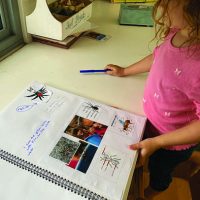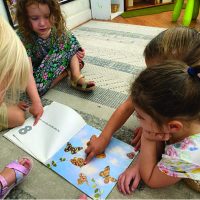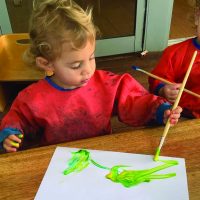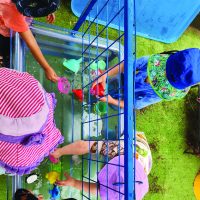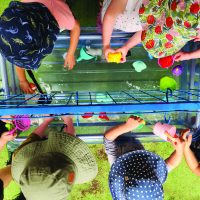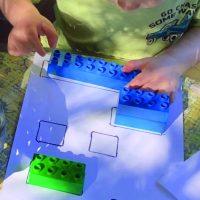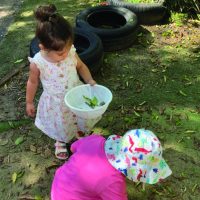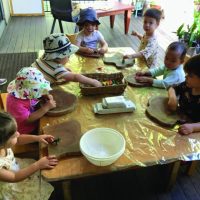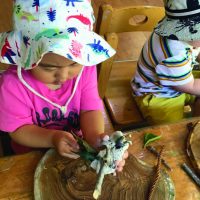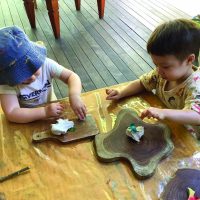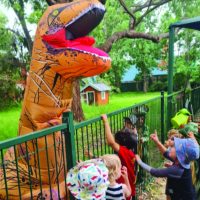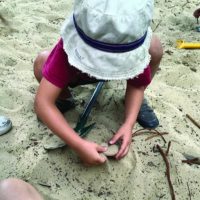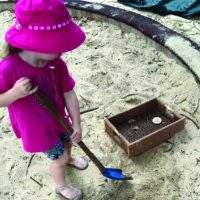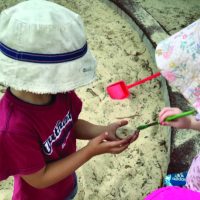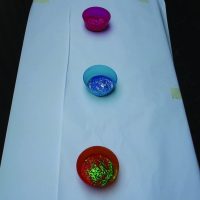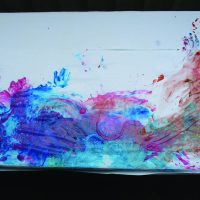Gorton House
Preschool
Story by Educator Nicky
The children in Gorton House preschool show a deep interest in and connection to the outdoors and nature in all its forms. We see and hear the joy they express as they engage in noticing every little bug, every wispy web, and even the tiniest of insects that they discovered, and the details, discoveries and observations that are shared.
We are inspired by the children’s fascination, and we recognise that these are meaningful and authentic teaching moments in which we can foster within children not only knowledge about, but also a love for, the natural world and for every little creature within it. We can feed the intrinsic curiosity that drives them to search for and notice what lives amongst us as they discover with delight, reinforcing that all these bugs belong on this land just as we do. We share this space, and we make space for each other.
One child frequently reminds us that every creature is part of her family, and she cares about all of them. Another child continues to be a protector—she is attuned to all talk of bugs/animals/creatures and will respond immediately to help in the rescue of any bug that needs relocating to the garden.
We have begun documenting some of our discoveries, using photos, children’s drawings and works, and the observations of Educators. The children have also enjoyed looking through a huge bug book which is the documentation created by previous Gorton House preschool children—our children discover some similar questions and discoveries by the previous group, and they recognise older siblings and familiar faces, further fostering a sense of community. Families have shared some of their own bug knowledge and have even helped us to research some of the children’s questions.
We expect that this interest will be a long and deeply absorbing one, and the children will lead its direction. We will also explore which of these bugs are native to the land and which have been introduced. We know that the bugs native to the land will have their own Darug names, so we hope to be able to learn and acknowledge these. In the meantime, we have been reading books that broaden our knowledge, and we have created a space where the children can handle and play with little plastic bug replicas. They have been creating little eco-systems, talking about families of bugs, and extending their vocabulary greatly as they explore terms and concepts such as ‘predators’ and ‘prey’, and engage in descriptive language to explain, describe and recall.
Toddlers
Story by Educator Ying
This month our Gorton House toddlers showed an interest in playing with trains. We have made a closed train track system at the learning area. The children helped connect the train track pieces and enjoyed pulling the trains along the tracks. To further support their interest and enhance the learning, we made trains with some cardboard boxes, which also encouraged the concepts of reusing and recycling resources. Together we cut and adjusted the boxes so that we could fit in them. Round paper shapes were used for the wheels and in the box at the front we also used circle shapes for the steering wheel and two start and stop buttons.
Many children joined in the experience. They helped by holding the glue stick, marker and tape, and sticking the wheels on, arranging the boxes in line and going inside to try the train. Our Speech Pathologist also had a talk with the children about the travelling by trains, and introduced the idea of waiting at the train station to get on board when all the carriages were full. The play experience was fun, with many children actively participating. They expressed their interest openly, contributed their ideas, helped to create the train, and enjoyed playing together. We will plan and organise more interesting experiences about vehicles to support the children’s interests and learning.
Babies
Story by Educator Chamani
In Gorton House babies’ room our little ones had a busy week painting and exploring colours. Recognising colours and identifying colour names is an important part of a child’s development. Early identification of colours helps to create the cognitive link between visual cues and words. Colouring, painting and drawing help children improve their fine motor skills and train the brain to focus. For parents and teachers, these inexpensive activities require limited preparation and are well-suited for children to participate in with excitement.
For this week’s experience I provide the children with two primary colours (blue and yellow) and talked about what those colours mean to us when we look at nature, and what happens when the two colours are combined. I also encouraged the children to focus on how they use the paint brushes to colour and to control the speed of their hands as these are important factors when children begin to develop their writing skills.
Earlier this week the children also participated in a collage activity. Collage projects are open-ended process art that are great experiences for any age group. Process art supports the development of creativity. Collages are a simple craft activity involving gluing paper, recycled or natural items to paper.
Through collage art young children are encouraged to express themselves through their work and to make choices without adult direction. There are many benefits to collage work, including the fine motor skills children practice, the development of independence through practice and repetition and making choices about their work.
Young children need to practice their fine motor skills, which involves using small muscles that work with the brain and nervous system to control movements. Fine motor skills are necessary for everyday tasks such as self-care and handwriting. Children practice fine motor skills when they glue, stick, staple, cut or tear collage materials.
Johnson House
Preschool
Story by Speech Pathologist Rebecca
It was wonderful to observe the children’s heads bent in concentration over the tray during a water play experience in Johnson House preschool recently. There was lots of splashing, squirting and observation of the water trickling through the brightly coloured cups. There was also lots of conversation! “I’ve got an octopus!”, “It’s a hammerhead shark”, “I saw it at Taronga Zoo” “Who wants soup?”
There are many benefits to water play. This includes supporting children’s language development, for example, when they use a variety of words to describe what they see and how they are playing, and encouraging their creativity and imagination, as there is no ‘right’ or ‘wrong’ way to play with water and there is no expected ‘outcome’ of this play.
Toddlers
Story by Educator Priya
We are currently in the process of welcoming new children and their families into Johnson House toddlers. Our children were very excited to meet their new peers and they displayed friendly behaviours towards them. We set up the environment with various learning experiences to provide the children with opportunities to learn through play.
The children have particularly enjoyed spending time at the block set up experience, where they were given different coloured pieces and had the opportunity to match the blocks to the drawings of the same colours and shapes. The children shared their resources and enjoyed matching the blocks with their peers. In the future we will continue to set up experiences like this to extend on the children’s communication, fine motor and cognitive skills.
Murray House
Toddlers
Story by Educator Yi
Over the past few weeks, the children in Murray House toddlers have had an emerging interest in dinosaur activities. They were observed spontaneously setting up dinosaurs in the sandpit and adding some leaves, pretending these were the dinosaurs’ food.
A group of toddlers asked me to read the book called ‘How Do Dinosaurs Eat Their Food?’. The children demonstrated curiosity and interest in dinosaurs’ environments and what kind of the foods they ate.
We followed up on this and read the book again, and the children were provided with small dinosaurs to explore in a small world play. The children were then invited to visit the garden to find some natural more resources to feed their little dinosaurs.
The toddlers were excited and enthusiastic in collecting resources from our garden and bringing them back to the table. The children were provided with some clay, and they were excited as they pressed their dinosaurs’ feet into their clay pieces to mark the dinosaurs’ footprints. When one child finished this task, he exclaimed, “I did it!” with confidence.
Some of the toddlers took their time choosing, before deciding to create a new living environment for their dinosaurs. They were seen patting their clay into bigger, round shapes and they started to put their dinosaurs on the clay one by one. One child said “Come, you are going to stay here!”. Another child asked him, “Is it the new house for the dinosaurs?”. “No, it’s the dinosaur island!”, he answered proudly. Wow, that was a good idea! Others copied him as they joined the group play.
Clay is a medium that promotes creativity and provides wonderful opportunities for toddlers to develop their self-confidence and encourages their self-expression. It also improves their problem-solving and social interaction skills as they engage with each other and learn something new from each other.
Robinson House
Story by Educator May
Continuing from yesterday’s ‘Dino Day’ activities in Robinson House we had a ‘Finding Fossils’ experience. We collected shovels from the shed and then examined the fossils we found in the sandpit. While we were searching for fossils, Riley P found a brush to wipe the sand off to reveal dinosaur imprints. “Brushes girl, brushes girl… can you brush my fossil?”, asked Riley L. After a while, we couldn’t find any new fossils—they were well camouflaged in the sand! “Maybe you should have made them rainbow,” suggested Riley P. Great idea! Freya and Heath decided to bury the already found fossils and mark them with an ‘X’. “I’ll make one for you Heath,” said Freya, and when Penelope asked for one later on, Freya said “Of course, of course,” in a sing-song-y manner. Great teamwork and exploration of our environments today!
I will extend upon the experience of adding new natural materials to their next exploration.
Community Playgroups
Story by Playgroup Coordinator Rebecca
This week at our Pathways Playgroup we introduced the children to finger painting. We have done painting on many occasions, but it has always been with a brush or another painting implement. As we have interacted with the children, we have noticed that many of them do not like to get paint on their hands. To encourage them to enjoy ‘messy play’ and to feel the paint we thought that finger painting was the way to go.
We put out three colours in bowls for the children to explore with their hands and we had a hand washing tub beside the paint table so that children could wash their hands as soon as they had finished. Having the water nearby also helped parents who were worried about their children making a mess.
Finger painting is a great way for children to explore, learn and develop through sensory play. The cool, squishy texture of the paint encourages children to experiment with mixing colours and creating patterns, and it strengthens finger and hand muscles and helps children to focus on the process rather than the finished product. It can also aid in the development of communication and language skills as children talk about the shapes and colours being created and how the paint feels on their hands.
The children had a lot of fun creating and learning with finger painting this week.
